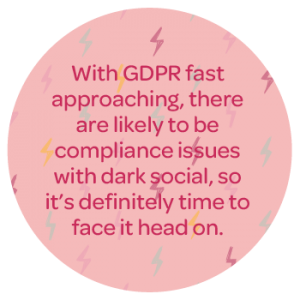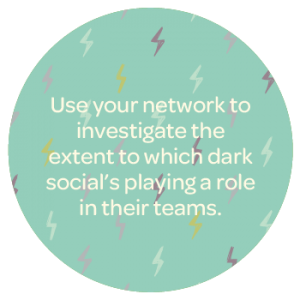Is the mask of dark social concealing employees’ true engagement with our communications? And with the threat of GDPR entering the ring, can we defeat it?
Reporting a campaign’s performance back to the boss can have even the best internal communicator’s back against the ropes.
Rightly or wrongly it’s always felt like internal communications has had a tougher time with measurement than our marketing and public relations luchadores, who can brag hard-hitting measures like the number of Twitter followers, share-of-voice, and AVE (advertising value equivalent).
A decade or so ago the biggest challenge for an internal communicator’s measurement was how to be sure a back-of-the-toilet-door poster got people talking down the pub on Friday evening.
Now with 80% of the world’s workforce non-desk based it’s online sharing that’s got us tapping out.
Dark social rises
The masked destroyer of measurement, dark social is the term given to the sharing of content through channels that web analytics can’t capture. Internally that tends to be mobile messaging apps like WhatsApp and Facebook Messenger, and personal email traffic.
With more than one in five employees saying they frequently send or receive work-related messages outside of core hours on their personal platforms, it’s perfectly viable that an employee could be taking your campaign’s content, and sharing it in their team’s unofficial WhatsApp group. This means you’ll see just one click on your intranet analytics and you’ll never know what they’re saying about it, unless they let you in.
With the new General Data Protection Regulation (GDPR) fast approaching in May, there are likely to be compliance issues with dark social in internal communications too, so it’s definitely the right time to face it head on.
How do we tackle dark social?
In today’s world, everyone’s a communicator. Almost all of your employees have personal mobiles, messengers and email, and a third of them are using them to access and share company information. A Yapster study found that shockingly 11% of employees they surveyed admitted to using them to share sensitive business information, like trading data and internal documents.
It’s clear that dark social is a tough beast to tackle, but we won’t be beaten. Ding Ding Ding.
- Round up an A-Team. If you want to go into battle with social, hit it with the old school. The internal communications network, either formal or informal, was packing a punch long before social media was even a pipe dream. With the right people in your network you’ll be able to find out how your campaign message landed, and share that insight back up as part of your measurement report. You can also use your network to investigate whether dark social’s playing a role in their team.

- WhatsApp to the rescue? 64% of 18-34 year olds say they use personal messaging services for work, so it makes perfect sense to hear that recently, WhatsApp launched a business app. It’s designed for small businesses, but can be applied to internal communications too. You’ll be able to measure the messages you send direct from your desktop were successfully sent, delivered, and read. And with document sharing up to 100MB, it’s a great tool for communicating with PDFs, documents, spreadsheets, videos and slideshows, and getting stats back. If you’re using the bog-standard WhatsApp messenger as an internal communications tool, now’s the time to look into how you’re using and storing employee data. There are huge fines at stake – €20 million or 4% of the company’s annual turnover; whichever is higher – if you’re not complying with GDPR.
- Drop in some share buttons or comment tools.I t goes without saying that this works better for external communicators who can point readers to social media, but adding some easy sharing buttons or commenting features on your intranet news stories, digital newsletters, and email communications could stop people ‘going dark.’ Granted, you don’t want to encourage or enable anyone to start posting sensitive company information to Twitter, so you’ll have to create something that’s right for your internal technology platforms and complies with security policies. You could use it as an opportunity to explore additions like Yammer or Yapster to your channel mix too.
- Could BYOD save us? BYOD stands for ‘bring your own device’ and it’s an initiative being adopted by an increasing number of companies, encouraging employees to use their own devices, such as mobiles and tablets, for work purposes. Close to nine out of 10 executives are now placing high importance on giving their front-line workers digital tools and platforms so they’re as connected as their office worker counterparts. BYOD enables them to do it without breaking the bank. There’s a lot of interesting views about BYOD. Some think that if it’s implemented carefully, with strict policies and procedures, having more of your workforce accessing company systems and information from their devices – and therefore, in their own time too – could mean they’re less likely to want to share things ‘in the dark.’ If teamed with something like an official WhatsApp group, Yammer app, or a mobile-friendly Sharepoint site, BYOD could help internal communicators’ take down dark social.
Five knockout tips to help you wrestle dark social
- Do your research. Find out what hold dark social has on your organisation.
- Become GDPR’s biggest fan. Learn about it. Get a grip on it. Take action.
- Network with your peers, and talk to the experts. You won’t be the first to tackle dark social and you won’t be the last.
- Team up with IT. A study found that 31% of employees are using personal cloud services without approval from their IT department, so they’re going to back you up against dark social.
- Expand your channels. Yes, budgets can be tight and regulators can be even tighter, but have a look at what apps, systems and tools are out there to help you bring social sharing out of the dark and into the light.
By Ellie Buckingham for Alive!
Sources:
















